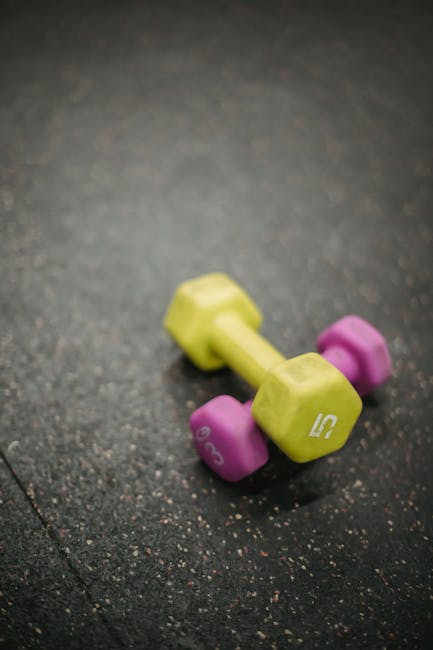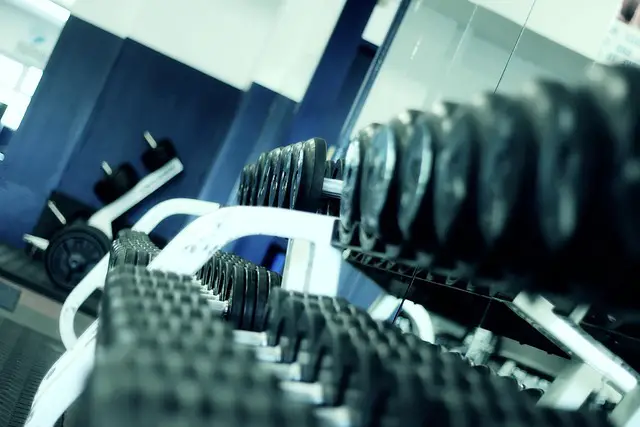Are you tired of hearing your Aunt Gertrude insist that weightlifting will stunt your growth? Do you secretly envy those jacked gym-bros but fear the consequences of lifting heavy? Well, hold onto your protein shakes because we’re about to bust a myth that’s been around since the dawn of time (or at least since the first caveman lifted a boulder): Does weightlifting really hinder growth? It’s time to separate fact from fiction, science from skepticism, and biceps from broscience. So grab some chalk, pump up the Jock Jams, and let’s get lifting!
Contents
- 1 1. Introduction: Examining the Myth Surrounding Weight Lifting and Growth
- 2 2. The Science Behind Muscle Growth and Development
- 3 3. Debunking the Common Misconceptions About Weight Lifting and Growth
- 4 4. The Benefits of Resistance Training for Children and Adolescents
- 5 5. Conclusion: Encouraging Safe and Effective Weight Lifting Practices for Youth Fitness
1. Introduction: Examining the Myth Surrounding Weight Lifting and Growth
So, you want to get jacked, eh? You’ve heard the rumors about weight lifting since the dawn of time. “Lifting stunts your growth,” they say. “You’ll end up short as a stump,” they cry. Well, I’m here to tell you that it’s time to debunk this myth once and for all. Here, we’ll examine the science and get to the truth behind the talk.
Firstly, let’s address the elephant in the room. No, weight lifting does not make you shorter. In fact, quite the opposite! You see, weight lifting can actually increase bone density and promote growth. So, the next time someone tells you that lifting weights will shrink you down like a raisin, you can confidently tell them to take their misinformation elsewhere.
Secondly, weight lifting doesn’t just help you grow physically, it increases your mental fortitude as well. When you start seeing progress in your lifts, the confidence you gain spills over into other areas of your life. Suddenly, that presentation you have to give at work doesn’t seem so daunting. You realize that if you can deadlift your own bodyweight, you can do just about anything.

2. The Science Behind Muscle Growth and Development
First things first, let’s get one thing straight: muscles don’t just magically appear overnight. (Hey, we can dream, can’t we?) No, muscle growth and development are actually the result of a complex process involving a number of different factors. Here are a few of the key players:
- Resistance training: This one might seem obvious, but it’s worth stating. Whether you’re using free weights, machines, or just your own bodyweight, resistance training is the primary stimulus for muscle growth.
- Nutrition: If you want to build muscle, you need to give your body the fuel it needs. That means eating enough protein, carbohydrates, and fats to support growth.
- Recovery: Contrary to popular belief, muscles don’t actually grow during a workout. Growth and development occur during the recovery process, when your body repairs the microscopic tears in your muscle fibers caused by resistance training.
Of course, the science of muscle growth and development is much more complicated than that. There are countless other factors that can influence the process, from genetics to sleep to stress. But if you’re looking to build muscle, focusing on these three key areas is a good place to start.
Just remember: progress takes time! You’re not going to pack on 10 pounds of muscle in a week (unless you’ve discovered some kind of magical unicorn protein powder, in which case, please share). But with consistent effort and smart training, you can gradually build the body you want.
3. Debunking the Common Misconceptions About Weight Lifting and Growth
It’s time to dispel the condescending gym myths about weight lifting and growth. Let’s unpack some misconceptions and finally set the record straight with humor and factual evidence, because science never lies, y’all.
First off, let’s address the elephant in the room: lifting weights will make you bulky and masculine. False! Several imposters have claimed this, but the truth is that weight training will not cause women to look like bodybuilders unless they are supplementing with testosterone or specific hormones. In fact, weight lifting is beneficial and critical for both genders because it helps protect bone density, increases muscle mass, and elevates metabolic rates to burn more calories throughout the day.
Another common misconception about weight lifting is that individuals will experience immediate results and significant muscle growth. Nope! Building muscle is a process, not a one-and-done stint. It requires consistency, dedication, and patience to see progress. Remember, quality trumps quantity in the gym. So instead of maxing out every time and risking an injury, focus on controlled, heavy lifts that challenge your muscles while maintaining good form. Incremental progression and recovery are key.
- Myth: Weight training turns fat into muscle.
- Fact: Sorry to burst your bubble, but fat and muscle are completely different types of tissues. Fat can’t morph into muscle, and vice versa. What weight training does is help increase muscle mass while burning fat at the same time, resulting in a leaner and toned body.
- Myth: You need to eat a ton of protein to build muscle.
- Fact: Yes, protein is essential for muscle growth and recovery, but it’s not the only factor in the equation. Resistance training, proper rest, and consuming enough calories to support muscle development also play a crucial role.
- Myth: Cardio should be avoided when trying to build muscle.
- Fact: False! Cardiovascular exercise is beneficial for overall health and can complement weight training. Just don’t overdo it to the point where it negatively affects muscle growth and recovery.
There you have it. We hope this clears up some of the myths and misconceptions about weight lifting and growth. Remember, consistency, proper form, patience, and a good sense of humor are the secret ingredients to achieve your desired muscle gains without falling victim to bogus claims and expectations.
4. The Benefits of Resistance Training for Children and Adolescents
Resistance training might make you think of muscle-bound bodybuilders, but it turns out that kids and adolescents can benefit from pumping iron as well. So let’s dive into the top perks of picking up those weights!
- Increase in Muscle Strength: Better muscle strength can lead to not only improved athletic performance but also reduced risk of injury while playing sports. Plus, your kids might finally be able to carry all the groceries in one trip!
- Boost in Confidence: Confidence doesn’t come just from good grades and supportive friends. Resistance training can help your child feel stronger and more accomplished, which can lead to increased self-esteem and a positive outlook.
- Bone Health: Did you know that childhood is the most important time for bone growth? Resistance training can help improve bone density, which can reduce the risk of fractures and osteoporosis later in life.
But wait, there’s more! Resistance training can also lead to improved balance, better sleep, and even decreased symptoms of depression. And the best part? Your child doesn’t even need to be a bodybuilder or powerlifter to reap the benefits. Just a few simple exercises a few times a week can make a huge difference!
5. Conclusion: Encouraging Safe and Effective Weight Lifting Practices for Youth Fitness
So, there you have it. After tons of research, we’ve discovered that encouraging safe and effective weight lifting practices for youth fitness is not only important but essential for achieving overall health and fitness goals. Here are a few key takeaways:
- 1. Start with the right form: Always make sure youth athletes are starting with the right form before adding in heavy weights.
- 2. Keep it safe: No one wants to get injured at the gym! Emphasize the importance of proper safety measures, like spotters and knowing when to stop.
- 3. Don’t overload: Just because someone is strong enough to lift a certain weight doesn’t mean they should. Be mindful of appropriate weight selection for individual fitness levels.
Now, we know what you’re thinking: “This is all great, but how do I get my kids interested in weightlifting in the first place?” Well, we’ve got a secret weapon:
- Make it fun: Incorporate games and challenges to make weightlifting seem like a fun activity rather than a chore. Maybe even throw in some friendly competition between family members or friends.
- Show off the gains: Who doesn’t love a little bit of positive reinforcement? Take progress pictures and celebrate achievements along the way.
At the end of the day, our goal should always be to prioritize the safety and health of our youth athletes. With proper education and encouragement, we can help them reach their full potential in the weight room and beyond. Now, let’s get lifting!
Lift those Weights, my Friend!
And that folks, wraps up our myth-busting article on weight lifting and growth. It’s high time we put this age-old myth to bed. Weightlifting does not hinder growth, but rather helps in building strong muscles and bones. So, don’t let the naysayers deter you from hitting the gym and pumping some iron. Go ahead and flex those muscles with pride because as they say, “Lifting weights won’t make you a giant, but quitting will make you a midget.” Keep lifting and keep growing, my friend!








Leave A Comment